The migration of Indo-Europeans from the East to the West is often discussed in European and American publications. In particular, in the book “History of the English”, researchers Robert Makram, William Crane and William McNeil expressed the opinion that the ancestral homeland of Indo-European languages could be in the territories where the Trypillians lived, that is, on the banks of the Dnipro River. This could happen after the decline of the Trypillian culture, when part of its population migrated to other territories, including Central and Southern Europe.
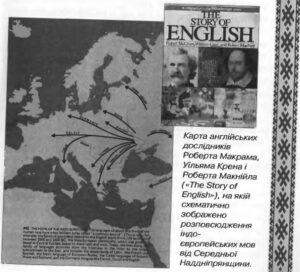
So, some part of the influence on the formation of Celtic, Slavic, Germanic and other languages could have come precisely from the descendants of the Trypillian culture. It is clear that this is only an assumption. But there are certain arguments for it, including the presence of ancient words from Sanskrit in various European languages. How this process could happen can be seen in the diagram below.
Researchers from Princeton University (USA) suggested that the formation of the Trypillian civilization and other archaeological cultures of Southern, Eastern and Central Europe was due to migration processes from East to West, which took place for a very long time – from the 9th to the 6th millennium B.C.
As you can see from the diagram below, they see the process something like this. From the 9th millennium B.C., it spread from East to West, to the territory of the modern Middle East and Turkey. Then, in the 8th-7th millennium B.C., agriculture spread throughout the territory of modern Turkey, where there were very favorable climatic conditions for it. Even later, around 6200-6000 B.C., agriculture spread to the territory of Europe, primarily to the territory of modern Greece, Bulgaria, Serbia, and Romania. And then, from these territories in the period from 6000 B.C., agriculture spread to Central Europe, as well as to the territory of modern Moldova and Ukraine.
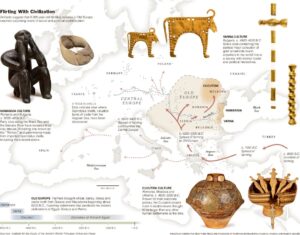
What gives historians and archaeologists reason to talk about the similarity of different civilizations on such large territories, and about their gradual spread, migration of tribes? First of all, there is a certain similarity between the findings of archaeologists in different territories (ceramic dishes, drawings on them, ancient symbols and signs, similar tools, methods of housing construction, similar religious cults, etc.).

This could be the path of the Trypillian tribes (more precisely, their ancestors) from the East to the West. During this time, ancient tribes covered a path of thousands of kilometers, spread their knowledge and civilization on the territory of millions of square kilometers. It is clear that all these assumptions are theoretical. It is extremely difficult to state anything definitively, especially when so much time has passed. However, scientists have accumulated many arguments in favor of such theories, including the results of archaeological excavations over the past 200 years. Therefore, it must be recognized that such theories have every reason to be considered quite well-argued.
Even more surprising is the incredible similarity of Trypillian ceramics with Yang-Shao ceramics, which existed as far away as China. There is every reason to believe that population migrations from East to West and from West to East were permanent. People traveled thousands of kilometers in search of new lands. Together with them, they carried knowledge, including the ability to make work tools, dishes, tools. Therefore, it is not surprising that figurines of deities and earthenware of the Trypillian culture and the Yang-Shao culture had many common features. Common ancient symbols are especially revealing.
No less interesting from the point of view of finding parallels with Trypillian are the ceramics of the Mogollon and Hohokhan culture in America (Anasazi-Mogollon, Hohokam) and the Ban-Shiang culture in Thailand (Ban-Chiang), listed in the UNESCO world heritage. It is not difficult to recognize the Trypillian design in them.
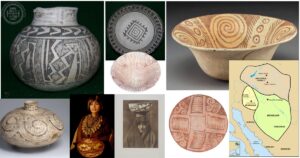
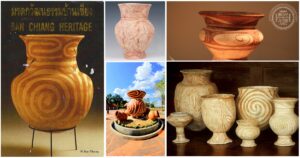
The question of how different civilizations, very distant from each other, could have such similar ceramics and other products has been of interest to historians and archaeologists for a long time.
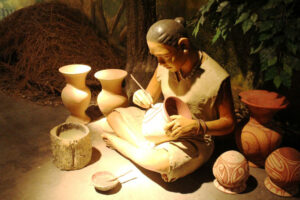
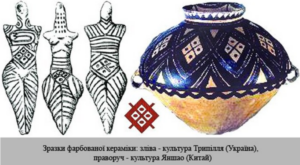
An interesting version is the gradual resettlement of ancient people, which occurred after resettlement from the center of the original civilization of mankind – Hwanguk, which existed in 7197-3897 B.C. (3301 years). After that, there was the Baedal period (it lasted 1565 years) and the Ancient Joseon (lasted 2096 years). Information about these events is set out in the ancient records of the history of Korea – “Hwandan Gogi”, which have survived to this day and are being studied by historians. These documents contain information about the ancient history of mankind, its culture. The documents are unique in that they tell about such ancient events in the history of mankind, about which there is no other written information in other sources.
According to Hwandan Gogi, Hwanguk’s territory was located in Central Asia (in modern Siberia, around Lake Baikal, the Tien Shan mountains, etc.). In the future, there was a resettlement of people both to the East and to the West. In this case, it can be explained why many ancient archaeological cultures of Eurasia have certain similar features (ceramics, tools, weapons, buildings, etc.). Also, the presence of a common ancient civilization could explain the similarity of symbols on ceramics, the similarity of tools, tools, weapons and other findings of archaeologists.
Information from Hwandan Gogi about the existence of an ancient civilization in Eurasia, which could be the ancestral home of many subsequent civilizations, caused a great public outcry. Historians and archaeologists have also shown great interest in it. Archaeologists believe that it is extremely difficult to prove the reliability of the information indicated in the ancient documents. Moreover, thousands of years have passed since the events, and no other reliable written information has survived. That is why the question of the origin and migration of various tribes in Eurasia remains extremely controversial in modern historical science.
On the territory of Ukraine, painted Trypillians ware continued to be made in several craft centers on the Dniester (Usativ archaeological culture). These products must have had a great value, because they are found, as a rule, in the richest burials, and even then in small quantities. This could mean that the majority of the population after the decline of the Trypillian civilization began to live worse, poorer, and beautiful painted tableware was available only to a small part of the population.
The Trypillian cult tradition became the property of future civilizations and tribes, just as it happened with the cultural heritage of other vanished civilizations of the Ancient World. Nowadays, we can only make assumptions as to how exactly the symbolism of the Neolithic era has survived to our days, but we can see ancient signs on Easter eggs and in embroidery, known even to the people of Tripillian culture: a rhombus divided into four parts (a sown field), a bereginia, an infinity, a spiral, a swarga etc.
It can be said that the people of Tripillian culture managed to leave a memory of themselves – thanks to what they created in the past, they are still remembered today. So, in a certain way, they achieved their goal – to preserve their memory for a long time, in eternity. Although, perhaps, it did not happen in the way they hoped. The study of mutual influences between the Trypillian civilization and other neighboring civilizations is promising, because every year there is more and more information, and it can be processed and analyzed.

Conclusions
As can be seen from the given facts, the Trypil civilization played an important role in the history of contacts between Western and Eastern ancient civilizations. She left a significant mark in the history of Ukraine and Eastern Europe.
Archaeological excavations made it possible to collect a large amount of material about the life, construction, rituals and customs of the people of Trypillian. Most historians agree that the formation of the Tripillian civilization was greatly influenced by the process of gradual resettlement of agricultural tribes, including from the East and South (from the territory of modern Turkey, Greece, Bulgaria) to the territory of modern Romania, Moldova, Ukraine, where they settled people from Trypillya. It is significant that the history of the Trypillian civilization was quite long – more than 1000 years. This indicates that she had a certain margin of strength, because otherwise she would not have lasted so long.
Archaeological findings (earthenware, tools, remains of buildings, etc.) allow us to trace certain relationships between the Trypillian civilization and its predecessors and successors. This is especially evident in common symbols, signs and drawings on pottery, and in the shapes of pottery. In Asia, Europe and America, there are several ancient civilizations whose clay products are very similar to each other in terms of artistic design. This indicates the presence of mutual influences between these civilizations. Of course, now it is difficult to say who and who had more influence, because a lot of time has passed, thousands of years. But common technologies, symbols, tools, and rituals can testify to the common origin of ancient civilizations. These questions will still need to be studied by the next generation of scientists.
Bibliography
1) Бурдо Н. Б., Відейко М. Ю. Трипільська культура. Спогади про золотий вік. – Харків, «Фоліо», 2007. // Burdo N.B., Videiko M. Yu. Trypillia culture. Memories of the golden age. – Kharkiv, Folio, 2007.
2) Бурдо Н.Б. Сакральный аспект архитектуры трипольских протогородов // Трипільські поселення-гіганти. Матеріали міжнародної конференції. – К.: Корвин-пресс, 2003.- С. 18-21. // Burdo N.B. Sacral aspect of the architecture of Trypillia proto-cities // Trypillia giant settlements. Proceedings of the international conference. – K.: Korvin-press, 2003. – P. 18-21.
3) Бурдо Н.Б. Реконструкція будівель трипільської культури. Методика та концепції // Трипільська культура. Пошуки, відкриття, світовий контекст. До 100-річчя із дня народження О. Ольжича. – К. : “ВІПОЛ”, 2007. – С. 29-48. // Burdo N.B. Reconstruction of buildings of Trypillia culture. Methods and concepts // Trypillia culture. Search, discovery, world context. To the 100th anniversary of O. Olzhych’s birth. – Kyiv: VIPOL, 2007. – P. 29-48.
4) Відейко М. Подорож до прадавньої країни. – Київ, «Вища школа», 2011. – 167 с. // Videiko M. Journey to the ancient country. – Kyiv, Higher School, 2011. – 167 p.
5) Відейко М.Ю. Енциклопедія Трипільської цивілізації. – Т. 1-2. – К., 2004. – 703 с. // Videіko M. Encyclopedia of Trypillia civilization. – Vol. 1-2. – K., 2004. – 703 p.
6) Відейко М.Ю., Терпиловський Р.В., Петрашенко В.О. Давні поселення України. – К.: Інститут археології НАНУ, 2005. – 193 с. // Videіko M., Terpylovskyi R., Petrashenko V. Ancient settlements of Ukraine. – K.: Institute of Archeology of the National Academy of Sciences, 2005. – 193 p.
7) Відейко М. Ю., Кот С. І. Наукова спадщина Олега Ольжича. – К.: Наш час, 2008. (Серія «Невідома Україна»). // Videіko M., Kot S. Scientific heritage of Oleg Olzhych. – K.: Nash chas, 2008. (“Unknown Ukraine” series).
8) Відейко М.Ю. Трипільська цивілізація у спадщині України: Матеріали науково-практичної конференції. – Київ: Видавничий центр “Просвіта”, 2004. 328 с. // Videіko M. Trypillia civilization in the heritage of Ukraine: Materials of the scientific and practical conference. – Kyiv: “Prosvita” Publishing Center, 2004. – 328 p.
9) Kashina T.I. Yangshao culture ceramics. – Novosibirsk, 1977. – 168 р.
10) Korea, Russia, and the Hwanguk Civilization (by Ahn Gyeong-jeon). – STB, Korea, 2021. – 197 p.
11) Лащук, Ю. Українське Трипілля, китайське Яншао і сучасне Поділля / Ю. Лащук // Артанія. – 2010. – № 1. – С. 59-62. // Laschuk Y. Ukrainian Tripillia, Chinese Yangshao and modern Podillia / Yu. Laschuk // Artania. – 2010. – No. 1. – P. 59-62.
12) Пашкевич Г.О. Відейко М.Ю. Рільництво племен трипільської культури. – К.: Інститут археології НАН України, 2006. – 145 с. // Pashkevich G.,Videіko M. Agriculture of the tribes of Trypillia culture. – K.: Institute of Archeology of the National Academy of Sciences of Ukraine, 2006. – 145 p.
13) Свод записей Самсонги, Хвангук понги, Синси понги / Перевод на корейский и комментарии Ан Гёнчжон. – Sangsaeng books, 2016. – 314 с. / Corpus of Records Samsongi, Hwanguk Pongi, Shinshi Pongi / Korean Translation and Commentary by An Gyeong-jeon. – Sangsaeng books, 2016. – 314 p.
14) Cтрелкова А.Ю. Трипілля та яншао: символіка орнаментів кераміки // Культурологічні студії.– К.: Видавничий дім “KM Academia”, 1999.– Випуск 2.– С. 103-117. // Strelkova A.Yu. Tripillia and Yangshao: Symbolism of Ceramic Ornaments // Cultural Studies. – K.: Publishing House “KM Academia”, 1999. – Issue 2. – P. 103-117.
15) Шилов Ю. А. Прародина ариев: История, обряды и мифы. – К.: СИНТО, 1995. – 744 с. // Shilov Y. The Aryan ancestral home: History, rites and myths. – K.: SYNTO, 1995. – 744 p.